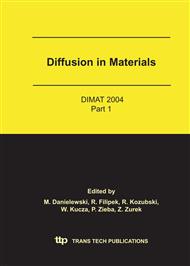p.891
p.899
p.911
p.922
p.928
p.934
p.940
p.946
p.952
Annealing of Fe-15at.%Cr Alloy in N2-H2 Gas Mixtures: Effect of Hydrogen
Abstract:
The effect of hydrogen during annealing of Fe-15.at%Cr alloy on the diffusion profile was investigated concerning the enrichment of chromium and the selective oxidation. Samples were exposed to an annealing gas mixture with different hydrogen contents in an infrared heating furnace and heated to 800oC, kept for 60 seconds and then cooled down to room temperature. After the experiments, field emission scanning electron microscopy (FE-SEM) equipped with electron back-scattering diffraction (EBSD) and x-ray photoelectron spectroscopy (XPS) were employed to characterize the morphology, elemental depth profiles and the chemical states of the elements. The annealing increased the Cr content at the surface in all atmospheres. The increase of hydrogen content in the atmosphere further increased the Cr to Fe ratio in near-surface, and the thickness of the layer affected by the heat treatment. The selective oxidation of chromium occurred as internal Cr2O3 formation, as a function of the Cr content, rather than the oxygen partial pressure. Hydrogen facilitated the diffusion of chromium probably by cleaning of fast diffusion paths.
Info:
Periodical:
Pages:
928-933
Citation:
Online since:
April 2005
Authors:
Keywords:
Price:
Сopyright:
© 2005 Trans Tech Publications Ltd. All Rights Reserved
Share:
Citation:


